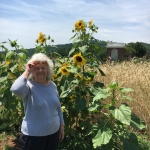by Carole Hemingway | Submitted Photos
Saratoga’s main attraction has always been its world-class thoroughbred race horses. The town’s signature race course opened on August 3, 1863, just a month after the Battle of Gettysburg. The blood on the battlefield was barely dry, and cannon fire still echoed in the hills, a sobering reminder of a conflict that seared and scarred a precious piece of the American landscape. I believe the Saratoga Race Course’s opening day was the first step to healing our country.
My first adventure to Saratoga was the last week in August 2010, to see Rachael Alexandra run in the PERSONAL ENSIGN. I met her face to face at dawn on the morning of her race. There’s nothing like a horse’s nose on your shoulders; it’s the best medicine on earth for whatever ails you. When I first laid eyes on the beautiful Rachel Alexandra, the $10 million horse of the year, I was captured by her sheer size and the grace in which she carried her beauty. She is a half a ton of sunshine. Feeling the magical tickle of her nose against my shoulders, the stimulation of her warm breath across my neck was about as good as it gets.
After that introduction, I thought to myself, “What could possibly compare with that moment?” I soon found out. The Backstretch. It’s what goes on behind the scenes that brings out those magnificent thoroughbreds to the starting gate. And only a few even get to see it up-close and personal. This was my lucky day. The Backstretch is a dizzying place of activity where six weeks of summer racing season starts the end of July, continues through Labor Day, and finds 800 workers—from many foreign cultures—managing to wrangle 1,800 horses in 91 barns. You’ve got to respect that.
These men often only get to see home and their families during the holiday season of winter and send their families money to provide for, among other things, their children’s education. This life is tough and really hard on the men, but it’s the way they have to do their jobs. They often live in dorms on the track grounds. They save their money. It may not be the most comfortable way to live, but somehow it works.
Sleep is a valued commodity—the men start waking up the horses at 5 a.m., and typically, the men wake up about 15 minutes before the horses, which barely gives them enough time to roll out of bed, still sleepy-eyed, and walk to their respective barns. The Backstretch Employees Service offers free breakfasts to all workers at Saratoga Springs Backstretch areas. Because many of the workers come from foreign countries and have no form of transportation while working at Saratoga, their food options are limited to what’s served at the track or what can fit on a hot plate. This is their only healthy food option. Candy vending machines are always empty.
The idea for the “health food program” came about after a Backstretch worker visited a dentist, who prescribed an antidote that required a full stomach. Much of the time the workers had no food in their dorms, so they were taken by a nonprofit shuttle service to a local grocery store, other local supermarkets, and Walmart twice a week. Then along came volunteers and donations for their own food service, and they were able to offer free hot meals six days a week.
The breakfasts extended to lunches and popular dessert options such as pie. All of this has given the men the energy to keep working because they get balanced meals. It is estimated that 5,000 meals are served throughout the racing season. Other services offer a computer center equipped with Skype so workers can communicate with their families back home, whom they likely won’t see again until December.
There’s also a free store where workers can pick up clothing and other supplies such as jeans, which are obviously popular, and a health care clinic staffed with doctors. There are Sunday dinners, Bingo nights, and even karaoke nights throughout racing season. As you can tell by reading this, there’s an outpouring of community support creating a Backstretch employee package that surpasses other race tracks. Help and support is why these horse racing events can take place, and as someone famous once said: “It indeed takes a village.”
 Carole Hemingway is an internationally regarded author, speaker, astrologer, and historical researcher. She lives along the coast of Maine, where she is currently writing three books on Gettysburg. The first volume is ex- pected to be released in November 2018.
Carole Hemingway is an internationally regarded author, speaker, astrologer, and historical researcher. She lives along the coast of Maine, where she is currently writing three books on Gettysburg. The first volume is ex- pected to be released in November 2018.
